Výzkumné projekty
AKTUÁLNĚ V ŘEŠENÍ
 Green Mine – celková revitalizace a resocializace lomu ČSA
Green Mine – celková revitalizace a resocializace lomu ČSA
Projekt je spolufinancován Evropskou unií.
Hlavním cílem projektu je dát udržitelnou budoucnost lokalitě zázemí uhelného lomu Československé armády a bývalému dolu Centrum a přispět k řešení sociálních, hospodářských a environmentálních problémů nejen samotné lokality lomu, ale také celého regionu.
Název programu: Operační program Spravedlivá transformace
Registrační číslo projektu: CZ.10.02.01/00/24_048/0000375
Nositel projektu: Sev.en Inntech a.s.
Partneři projektu:
- Česká zemědělská univerzita v Praze
- Hospodářská a sociální rada Ústeckého kraje, z.s.
- Univerzita Jana Evangelisty Purkyně v Ústí nad Labem
- Vysoká škola chemicko-technologická v Praze
- VUHU a.s.
- Výzkumný ústav pro krajinu, v. v. i.
Termín realizace: 1. 1. 2024 – 31. 12. 2027
Způsobilé výdaje: 639 392 044,64 Kč
Dotace: 530 313 181,48 Kč
UKONČENÉ PROJEKTY
 Možnosti využití vedlejších energetických produktů v cirkulární ekonomice
Možnosti využití vedlejších energetických produktů v cirkulární ekonomice
Předmětem projektu je výzkum možností alternativního využití vedlejších energetických produktů (VEPů) jako recyklované suroviny pro výrobu udržitelných produktů uplatnitelných ve stavebnictví.
Cílem projektu je získání nových znalostí pro vývoj nových inovativních a tržně uplatnitelných produktů z vedlejších energetických produktů prostřednictvím aktivit průmyslového výzkumu a experimentálního vývoje. Cíle projektu bude dosaženo v účinné spolupráci s odborníky z Fakulty strojního inženýrství Univerzity Jana Evangelisty Purkyně v Ústí nad Labem a odborníky z firmy Sev.en Inntech a.s. (členem energetické skupiny Sev.en Energy, která provozuje dva povrchové lomy na hnědé uhlí a současně také dvě hnědouhelné elektrárny v ČR – Počerady a Chvaletice). Hlavními aktivitami projektu bude systematický průzkum úložišť popílků a strusky těchto dvou elektráren včetně charakterizace současně produkovaných vedlejších energetických produktů a dále zejména návrh, příprava a testování nových produktů vyrobených z VEPů a možností využití těchto materiálů ve stavebním průmyslu s ambicí maximální trží uplatnitelnosti.
Inovačním prvkem projektu je návrh a testování nových produktů, které díky svým mechanickým, tepelným, izolačním a dalším vlastnostem budou využitelné ve stavebnictví, ať už se bude jednat o stavební materiály (tvarovky, cihly) či formy na lití betonu/kovolití s využitím technologie 3D tisku/extruze nebo tlakového lití a v konečném důsledku přispějí k úspoře prvotních surovin využívaných ve stavebnictví. Využitím popílků a strusek ve formě produktů ve stavebnictví (ne pouze materiálů jako doposud) dojde k výrazné úspoře emisí CO2, které vznikají při výrobě výrobků na bázi cementu, pálených cihel nebo dalších relevantních produktů. Výzkum umožní dále rozvinout principy cirkulární ekonomiky a najít nákladově optimální způsob recyklace energetických produktů a podpořit udržitelné stavebnictví.
Projekt bude realizován ve dvou etapách a bude rozdělen do tří výzkumných úkolů.
Výstupem projektu budou 2 užitné vzory:
- Prototypový výrobek tvarovky po extruzi/tlakovém lití (technologie, složení, vlastnosti) / technologická příprava geopolymerní směsi pro extruzi/tlakové lití
- Prototypový výrobek tvarovky po 3D tisku (technologie, složení, vlastnosti) / technologická příprava geopolymerní směsi pro 3D tisk
- Termín realizace: 1.9.2021 – 31.5.2023
- Příjemce: VUHU a.s.
- Partneři: Univerzita Jana Evangelisty Purkyně v Ústí nad Labem, Sev.en Inntech a.s.
- Číslo projektu: CZ.01.1.02/0.0/0.0/21_374/0027250
- Celkové způsobilé výdaje: 10 339 827 Kč
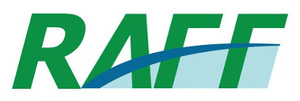 RAFF – Risk assessment of final pits during flooding
RAFF – Risk assessment of final pits during flooding
The RAFF project aims to research issues related to pit lakes, which is one of the most common uses of post exploitation voids. Up to now, in Europe, there is no precedent for the creation of a pit lake of a brown coal open pit mine of the volume c.a. 1,5 billion cubic meters. There are many examples of flooded smaller final pits and in some of these, during the process of filling with water, serious geotechnical problems have been encountered. It is expected that during reclamation of open pits of volume 1,5 billion m³ the scale of geotechnical problems will be significant and may impede the process of filling the voids with water. Almost all such artificial lakes are currently (and in the future) dedicated to recreational purposes. To ensure safe utilization of these localities by the public, it is necessary to assess the risk of instability of these areas, and evaluate the long-term monitoring. The main objectives for monitoring the abandoned open-pit mines are: geotechnical stability of the close vicinity and especially the slopes (both under the water level and the final slopes around the lake); the quality of water (chemical composition), not only in the lake itself but also in the close vicinity and all water feeding into the lake. The main aims of the project are connected with the creation of comprehensive models that can be used for risk assessment purposes. Innovative outcomes of the project will contribute to methodologies and guidelines to improve the safety, security, and environment aspects of flooded open pit mines. The project will carry out in-situ investigation, laboratory tests, and numerical and physical modelling to achieve the objectives. Thirteen deliverables are planned to be developed within the RAFF project, especially methodologies, numerical models and guidelines.
- Provider: Research Fund for Coal and Steel
- Period: 2019 - 2022
- Principal researcher: Ing. Lukáš Žižka, Ph.D.
- Project partners: POLTEROGR (POL) – VUHU (CZE) - POLYTECHNEIO KRITIS (GRE) - INSTITUT NATIONAL DE L ENVIRONNEMENT ET DES RISQUES (FRA) - ETHNIKO KENTRO EREVNAS KAI TECHNOLOGIKIS ANAPTYXIS (GRE) - THE UNIVERSITY OF NOTTINGHAM (UK) - GLOWNY INSTYTUT GORNICTWA (POL) - UNIVERSITATEA DIN PETROSANI (ROM) – DIAMO (CZE) - CTL MACZKI-BÓR (POL) – SUBTERRA INGENIERIA (SPA) - SOCIETATEA COMPLEXUL ENERGETIC OLTENIA (ROM)
Reservoir slopes represent crucial components of infrastructure that are central to the management and distribution of water resources. Ensuring the stability of these slopes is not only vital for safeguarding lives, property, and the environment but also for protecting the interests of stakeholders and ensuring the seamless functioning of various civil operations. To address these multifaceted concerns, the "Guidelines for Testing Materials Affecting Reservoir Slope Stability" have been developed. These guidelines are intended to serve as a comprehensive reference manual for a wide range of individuals, including geotechnical engineers, engineering geologists, stakeholders, and civil operators.
The scope of these guidelines extends beyond the realm of geotechnical professionals. They have been designed to cater to a diverse audience of stakeholders and civil operators who are associated with reservoir projects and related civil infrastructure. The guidelines offer a holistic approach to understanding and managing reservoir slope stability, addressing a broad range of geological conditions and project requirements. Whether you are an engineer, a project investor, a regulator, or anyone with a vested interest in reservoirs, these guidelines are a valuable resource for you.
Geotechnical engineering plays a pivotal role in safeguarding reservoir slopes, a role that affects everyone connected to these structures. This section highlights the central role of geotechnical engineers and engineering geologists in the evaluation, analysis, and design of reservoir slopes. It emphasizes that geotechnical professionals act as critical partners in ensuring the safety and stability of reservoir slopes and, by extension, the well-being of stakeholders and the smooth functioning of civil operations.
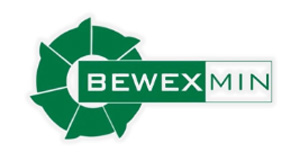 BEWEXMIN – Bucket wheel excavators operating under difficult mining conditions including unmineable inclusions and geological structures with excessive mining resistance
BEWEXMIN – Bucket wheel excavators operating under difficult mining conditions including unmineable inclusions and geological structures with excessive mining resistance
In newly-opened as well as existing lignite mines occur increasingly difficult mining conditions due to the presence of a growing number of unmineable inclusions and inclusions with an excessive mining resistance. During exploitation of such materials there are large dynamic and impulse loads. This results in frequent breakdowns and therefore exclusion of machines from normal operation. The aim of the project was to develop solutions to reduce failure rates of bucket wheel excavators working in such conditions. This could be achieved either by reducing the sensitivity of excavators on pulse load or by efforts to reduce the size of dynamic loads. Research in the BEWEXMIN project included three work packages. The first package included: experimental determination of the dynamic surplus from mass forces and linkage of these surpluses with physico-mechanical characteristics of exploited soils; method for determining alternative computational strength of pulse loads; determination of the requirements for flawless excavator work in specific conditions. In the second work package a way to create a system to monitor stress of excavator’s structures leading to continuous assessment of the degree of construction effort, signalling damage possibility, was created. The activities included in the third work package aimed to eliminate or reduce value of pulse loads caused by encountering unmineable obstacle by means of early detection of stones. All three WPs were interrelated and constituted a complete set of activities aiming at the same goal, which was to reduce failure rates of bucket wheel excavators operating in difficult mining conditions
- Provider: Research Fund for Coal and Steel
- Period: 2019 - 2022
- Principal researcher: Ing. Vlastimil Moni, Ph.D.
- Project partners: UNIVERSTIY OF NOTTINGHAM (UK) – POLTEROGR (POL) – VUHU (CZE) - ETHNIKO KENTRO EREVNAS KAI TECHNOLOGIKIS ANAPTYXIS (GRE) – INSTITUT NATIONAL DE L ENVIRONNEMENT ET DES RISQUES (FRA) – KOMAG (POL) – EMAG (POL) – GLOWNY INSTYTUT GORNICTWA (POL) – LUBELSKI WEGIEL BOGDANKA (POL) – DIAMO (CZE) - CTL MACZKI-BÓR (POL) – PUBLIC POWER CORPORATION (GRE)
 SUMAD – Sustainable use of mining waste dumps
SUMAD – Sustainable use of mining waste dumps
The SUMAD project unties European experts to investigate the future use of made-ground consisting of coal-mining spoil with a focus on the geotechnical, sustainability, environmental, socio-economic and long-term management challenges. Advanced risk analysis and physical and numerical modelling will be applied to different sustainable rehabilitation schemes with a particular focus on the technical viability for the development of renewable energy infrastructure. Tip operators and developers as well as authoritative bodies involved in the project will provide valuable input to ensure the maximum possible impact. A case-study site will be used as a test-bed for the concepts developed during the project.
- Provider: Research Fund for Coal and Steel
- Period: 2019 - 2022
- Principal researcher: RNDr. Jan Burda, Ph.D.
- Project partners: UNIVERSTIY OF NOTTINGHAM (UK) – POLTEROGR (POL) – VUHU (CZE) - ETHNIKO KENTRO EREVNAS KAI TECHNOLOGIKIS ANAPTYXIS (GRE) – INSTITUT NATIONAL DE L ENVIRONNEMENT ET DES RISQUES (FRA) – KOMAG (POL) – EMAG (POL) – GLOWNY INSTYTUT GORNICTWA (POL) – LUBELSKI WEGIEL BOGDANKA (POL) – DIAMO (CZE) - CTL MACZKI-BÓR (POL) – PUBLIC POWER CORPORATION (GRE)
 TEXMIN – The impact of extreme weather events on mining operations
TEXMIN – The impact of extreme weather events on mining operations
Whilst extreme weather events that are consequence of climate change has been a well-researched subject for many years, it is only recently that the subject has appeared on the radar of the international mining industry. Some mines have already faced issues relating to increased severe weather events so this issue needs to be addressed. The scenarios of climate change indicate that these types of events will be more frequent and violent.
TEXMIN project will identify and evaluate environmental impacts on operating, closed and abandoned mines caused by short term increases in extreme weather events and long-term climate change. Climate change scenarios will be calculated from regional climate models and climate baseline review. Impacts brought about by increases in precipitation, temperature and sudden changes in atmospheric pressure will be identified and evaluated with respect to mines across Europe. These will focus on issues such as minewater, gas emissions and structural stability. Risks will be assessed, adaptation & monitoring strategies and tool will be proposed and developed to mitigate current and future impacts. Some of the remedial actions proposed for shafts and spoil dumps will be applied and tested in pilot scale.
- Provider: Research Fund for Coal and Steel
- Period: 2019 - 2022
- Principal researcher: RNDr. Michal Řehoř, Ph.D.
- Project partners: GLOWNY INSTYTUT GORNICTWA (POL) – UNIVERSITY OF EXETER (UK) – POLITECHNIKA SLASKA (POL) – SUBTERA (SPA) – ETHNIKO KENTRO EREVNAS KAI TECHNOLOGIKIS ANAPTYXIS (GRE) – DMT GmbH & CO (GER) – VUHU (CZE) – SPOLKA RESTRUKTURYZACJI KOPALN (POL) – TAURON WYDOBYCIE SPOLKA AKCYJNA (POL)
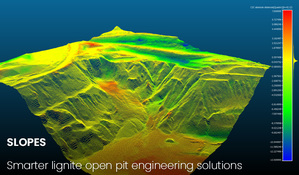 SLOPES
SLOPES
The SLOPES project brought together experts from across Europe to advance the current technology and methodologies applied to understanding, analysing, and monitoring slopes within open pit lignite mines. The project targeted three main areas. Firstly, the research evaluated how modern monitoring techniques can be applied and integrated within automated systems that provide ‘real-time’ assessments of risk. A particular focus was the potential use of unmanned aerial vehicles because of their versatility and that they reduce the need to have people and equipment in hard to access and potentially dangerous areas. Secondly, the project conducted a variety of stability analyses of open-pit rock-face slopes. Advanced probabilistic analyses were developed, giving improved methods for evaluating the performance and potential risks associated with open-pit slope faces. Advanced numerical modelling techniques were applied to gain an in-depth understanding of the behaviour of the slope faces, as well as an assessment of the potential vulnerability of mining and other nearby infrastructure. Finally, the project studied the long-term behaviour of lignite mine spoil materials, with particular attention on stability and ground movements within spoil heaps and reclaimed ground. A rigorous approach involving laboratory testing of soils, small-scale physical modelling (including elevated gravity modelling using a geotechnical centrifuge), and numerical/probabilistic modelling was applied. The project outcomes will enable development of effective reliability-based methods for the evaluation of risks based on monitoring and modelling results which will provide significant benefits to design optimisation and decision support within open-pit lignite mines.
- Provider: Research Fund for Coal and Steel
- Period: 2015 - 2018
- Principal researcher: RNDr. Jan Burda, Ph.D.
- Project partners: UNIVERSTIY OF NOTTINGHAM (UK) – GEOCONTROL (SPA) – SUBTERRA (SPA) – POLTEGOR (POL) – VUHU (CZE) – CENTRE FOR RESEARCH AND TECHNOLOGY-HELLAS (GRE) – UNIVERSITY OF EXETER (UK) – GLOWNY INSTYTUT GORNICTWA (POL) – LUBELSKI WEGIEL BOGDANKA (POL) – DIAMO (CZE) - CTL MACZKI-BÓR (POL) – INSTITUT NATIONAL DE L ENVIRONNEMENT ET DES RISQUES (FRA)
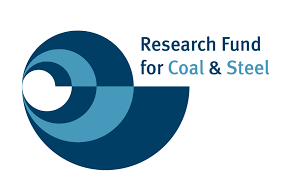 DIRPRIMCOAL – Direct Primary Coal Liquefaction via an Innovative Co-processing Approach with Waste and Petroleum Feedstocks
DIRPRIMCOAL – Direct Primary Coal Liquefaction via an Innovative Co-processing Approach with Waste and Petroleum Feedstocks
DIRPRIMCOAL is a research project with the goal to improve the feasibility and environmental performance of direct coal liquefaction (DCL) without the need for extremely large-scale plant and with a focus on low-rank and perhydrous coals (including wastes). The primary DCL products will be then investigated as a raw material for a co-processing with petroleum fractions in existing refinery facilities. The test programme will cover both catalytic cracking and hydrocracking of heavy fractions and a hydro-isomerisation of the naphtha. The research will identify and implement the improvements that need to be made to existing catalysts to optimally co-process heavy coal liquids and petroleum fractions.
- Provider: Research Fund for Coal and Steel
- Period: 2016 - 2019
- Principal researcher: Ing. Lukáš Anděl
- Project partners: UNIVERSTIY OF NOTTINGHAM (UK) – UniCRE (CZE) – ESTRA ENERGY TECHNOLOGY STRATEGIES (UK), VUHU (CZE) – SOLUCIONES CATALITICAS IBERCAT (SPA) – MOTOR OIL (HELLAS) DIILISTIRIA KORINTHOU (GRE) – LABORATORIO NACIONAL DE ENERGIA E GEOLOGIA (POR) – ETHNIKO KENTRO EREVNAS KAI TECHNOLOGIKIS ANAPTYXIS (GRE) – CIEMAT (SPA) – UNIVERSITY OF ULSTER (IRE)
 COALBYPRO – Innovative Management of COAL BY - PROducts leading also to CO2 emissions reduction
COALBYPRO – Innovative Management of COAL BY - PROducts leading also to CO2 emissions reduction
Coal ash is disposed of or used in different ways depending on the type of by-product, the processes at the plant and the regulations the power plant has to follow. Some power plants may dispose of it in surface impoundments or in landfills. Others may discharge it into a nearby waterway under the plant's water discharge permit. Coal ash may also be recycled into products like concrete or wallboard. Coal ash contains contaminants that without proper management, they can pollute waterways, ground water, drinking water, and the air. Therefore, the disposal of the by-products has become an important issue. Considering that coal combustion emits a great amount of CO2, the produced fly ash can be used as a material for on-site CO2 capture and storage (CCS).
COALBYPRO is a research project co-funded by the European Commission under the Research Fund for Coal and Steel (RFCS) having as a main goal to encounter new methods for the management of the coal/ lignite by-products and at the same time deal with the CO2 that is emitted during the fuel combustion.
- Provider: Research Fund for Coal and Steel
- Period: 2017 - 2020
- Principal researcher: Ing. Lukáš Anděl
- Project partners: CENTRE FOR RESEARCH AND TECHNOLOGY HELLAS (GRE) - UJV REZ (CZE) – VUHU (CZE) - GLOWNY INSTITUT GORNICTWA (POL) - VYSOKA SKOLA CHEMICKO-TECHNOLOGICKA V PRAZE (CZE) - TECHNISCHE UNIVERSITATE BERGAKADEMIE FREIBERG (GER)
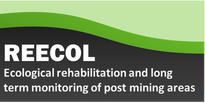 REECOL
REECOL
The REECOL project gathers eleven partners representing research institutions and industrial partners such as coal mining companies from five European countries. The partnership aims at close collaboration with an intention to ensure long-term environmental sustainability of coal regions in transition. The REECOL project activities are directed towards a significant improvement of post-mining ecological rehabilitation approaches which take into account ecosystem degradation degree, future intended land uses, affordability of the solutions and impact of climate change. New solutions for post-mining land reclamation, revegetation and ecosystem rehabilitation will be developed and tested in selected case study areas in different coal regions in transition. In addition, the partnership will implement measures for efficient short- and long-term monitoring of the rehabilitation processes with the use of various biological and geochemical indicators and remote sensing technology. The developed solutions will help establish appropriate ecosystems for the purpose of providing soil erosion control, water quality, wildlife habitat, and improved aesthetics of former mining sites to be reorganised towards other uses. A new certification method to evaluate ecological rehabilitation of post-mining areas and identify industry best practice in this field will be presented by the project and validated by the industrial project partners. The project will deliver a novel and innovative research with direct and positive impacts on the coal regions in transition and support sustainable ecological rehabilitation options with long-term viability and good socio-ecological performance.- Provider: Research Fund for Coal and Steel
- Period: 2023 - 2026
- Principal researcher: RNDr. Michal Řehoř, Ph.D.
- Project partners: POLTEGOR – INSTYTUT (POL) - INSTYTUT GÓRNICTWA ODKRYWKOWEGO (POL) - VUHU a.s. (CZE) - GŁÓWNY INSTYTUT GÓRNICTWA (POL) – PAŃSTWOWY INSTYTUT BADAWCZY (POL) - BUREAU DE RECHERCHES GÉOLOGIQUES ET MINIÈRES (FRA) - INSTITUT NATIONAL DE L’ENVIRONNEMENT INDUSTRIEL ET DES RISQUES (FRA) - INSTYTUT TECHNIKI GÓRNICZEJ KOMAG (POL) - DIMOSIA EPICHEIRISI ILEKTRISMOU (GRE) - VALORHIZ SAS (FRA) - POLSKA GRUPA GÓRNICZA SA (POL) - PREMOGOVNIK VELENJE, D.D. (SLO) - POLYTECHNEIO KRITIS (GRE)
© 2025 VUHU a.s., Kontaktovat webmastera, Mapa stránek
ANTEE s.r.o. - Tvorba webových stránek, Redakční systém IPO

